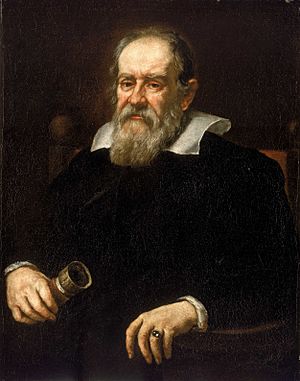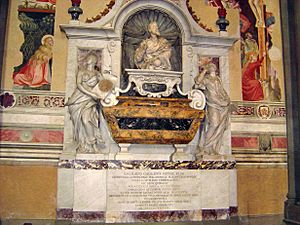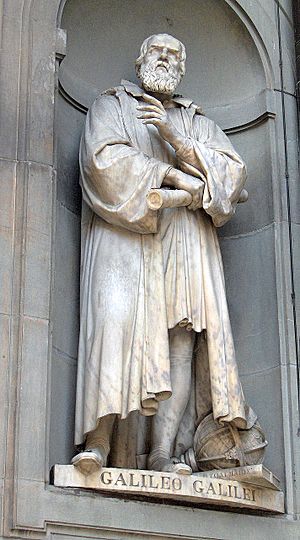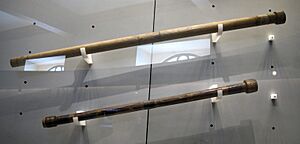Galileo Galilei facts for kids
Quick facts for kids
Galileo Galilei
|
|
|---|---|

Portrait of Galileo Galilei (1636), by Justus Sustermans
|
|
| Born | 15 February 1564 |
| Died | 8 January 1642 (aged 77) Arcetri, Grand Duchy of Tuscany
|
| Nationality | Italian |
| Alma mater | University of Pisa 1580–1585 (no degree) |
| Known for | |
| Scientific career | |
| Fields | Astronomy, physics, engineering, natural philosophy, mathematics |
| Institutions |
|
| Patrons |
|
| Academic advisors | Ostilio Ricci |
| Notable students |
|
| Signature | |
 |
|
Galileo Galilei (born 15 February 1564, died 8 January 1642) was a brilliant Italian scientist, astronomer, and engineer. He is often called the "father of modern science" because of his important discoveries and the way he studied the world through experiments and careful observation.
Galileo was born in Pisa, Italy. He made many discoveries about how things move, like speed and gravity. He also invented useful tools, such as an early thermometer and a special compass for military use.
One of his biggest achievements was improving the telescope. With his new telescope, he looked at the sky and saw amazing things:
- The stars of the Milky Way
- The different phases of Venus (like the Moon has phases)
- The four largest moons orbiting Jupiter (now called the Galilean moons)
- The rings of Saturn
- Craters on the Moon
- Sunspots on the Sun
Galileo also built an early microscope to look at tiny things up close.
His support for the idea that the Earth goes around the Sun (called heliocentrism), instead of everything going around the Earth, caused problems with the Catholic Church. In 1615, the Church said his ideas went against the Bible.
Later, Galileo wrote a book called Dialogue Concerning the Two Chief World Systems (1632) where he defended his views. This made the Church very upset. He was put on trial by the Roman Inquisition, found "strongly suspected of heresy," and forced to say he was wrong. He spent the rest of his life under house arrest. Even then, he continued his scientific work, writing another important book called Two New Sciences (1638), which was about how things move and the strength of materials.
Contents
Early Life and Family
Galileo was born in Pisa on 15 February 1564. He was the first of six children. His father, Vincenzo Galilei, was a famous musician and composer. Galileo learned to play the lute and was very good at it. From his father, he also learned to question old ideas, which was important for his scientific work.
When Galileo was eight, his family moved to Florence. He later joined them and studied logic at the Vallombrosa Abbey from 1575 to 1578.
Name
Galileo often just used his first name. In Italy at that time, using only a first name was common. Both his first name, Galileo, and his family name, Galilei, came from an ancestor named Galileo Bonaiuti, who was an important doctor and politician in Florence in the 1400s.
Galileo's Scientific Journey
Galileo first thought about becoming a priest, but his father encouraged him to study medicine at the University of Pisa in 1580. While studying, he noticed a swinging chandelier in the Cathedral of Pisa. He observed that no matter how wide the swings were, they seemed to take the same amount of time. This led him to study pendulums.
At first, Galileo was kept away from mathematics because doctors earned more money. But after accidentally attending a geometry lecture, he convinced his father to let him study mathematics and the study of nature (natural philosophy) instead of medicine.
In 1586, he published a small book about a special balance he invented, which helped him become known in the scientific world. In 1589, he became a professor of mathematics in Pisa. In 1592, he moved to the University of Padua, where he taught geometry, mechanics (the study of motion and forces), and astronomy until 1610. During this time, he made many important discoveries.
Astronomy Discoveries
Observing Supernovas
Galileo studied a very bright "new star" (a supernova) that appeared in 1604. Since this new star didn't seem to move in the sky like closer objects, Galileo realized it must be a very distant star. This went against the old idea from Aristotle that the heavens (the sky and everything in it) were perfect and unchanging.
The Refracting Telescope
In 1609, Galileo heard about a new invention from the Netherlands: the telescope. He quickly built his own, making improved versions that could magnify things up to 30 times! His telescopes were so good that he could use them to observe the sky. He also sold them, which helped him earn money.
On 25 August 1609, he showed one of his early telescopes to leaders in Venice. In March 1610, he published his first astronomical observations in a book called Sidereus Nuncius (which means Starry Messenger).
The Moon's Surface
On 30 November 1609, Galileo pointed his telescope at the Moon. He wasn't the very first person to see the Moon through a telescope, but he was the first to figure out that the dark and light spots were actually mountains and craters. He even made maps of the Moon's surface and estimated the heights of its mountains. This showed that the Moon was not a perfectly smooth sphere, as Aristotle had believed.
Jupiter's Moons
On 7 January 1610, Galileo saw three small "stars" near Jupiter. Over the next few nights, he noticed their positions changed in a strange way. By 10 January, he realized they were not stars but objects orbiting Jupiter! He soon found a fourth one. He named them the "Medicean stars" after his patron, but later astronomers renamed them the Galilean moons in his honor. These moons are now called Io, Europa, Ganymede, and Callisto.
This discovery was a big deal because it showed that not everything in the sky revolved around the Earth. A planet (Jupiter) had its own smaller planets (moons) orbiting it. This challenged the old idea that Earth was the center of everything.
Galileo even thought his discovery could help sailors find their longitude (their east-west position) at sea, by using the predictable eclipses of Jupiter's moons as a universal clock. While it was too hard to do this on a moving ship, the method was later used for mapping land.
Phases of Venus
Starting in September 1610, Galileo observed that Venus showed a full set of phases, just like the Moon. This was very important because the heliocentric model (Earth orbits the Sun) predicted these phases, but the old geocentric model (Earth is the center) could not explain them. This observation was strong evidence that Venus orbits the Sun, supporting the ideas of Nicolaus Copernicus.
Saturn and Neptune
In 1610, Galileo also observed Saturn. At first, he thought its rings were two smaller planets on either side, making it look like a three-part system. Later, when the rings were edge-on to Earth, they seemed to disappear, which confused him. The rings reappeared in 1616.
Galileo also saw the planet Neptune in 1612, but he didn't realize it was a planet. He just noted it as a dim star that moved.
Sunspots
Galileo studied sunspots on the Sun. The fact that the Sun had spots also challenged the idea that heavenly bodies were perfect and unchanging. He had a disagreement with another scientist, Christoph Scheiner, about who discovered them first.
The Milky Way and Stars
Galileo pointed his telescope at the Milky Way, which people thought was a cloudy mist. He discovered it was actually made up of countless stars packed so closely together that they looked like a cloud from Earth. He also found many other stars that were too faint to see with the naked eye.
He noticed that through the telescope, planets looked like small disks, but stars still looked like tiny points of light, just brighter. This was an important observation for understanding the vast distances to stars.
Theory of Tides
Galileo believed his theory about tides would prove that the Earth moves around the Sun. He thought tides were caused by the sloshing of water in the oceans as the Earth rotated and revolved around the Sun.
However, his theory was not completely correct. It predicted only one high tide per day, but most places have two high tides daily. He also didn't believe that the Moon caused the tides, an idea that was already known by some at the time and is now accepted as true.
Scientific Contributions
Galileo made huge contributions to science by combining experiments with mathematics. He was one of the first to clearly state that the laws of nature are mathematical. He wrote that "Philosophy is written in this grand book, the universe... It is written in the language of mathematics."
He understood the importance of setting up experiments carefully, with standards for length and time, so that results could be repeated and confirmed. This was a big step towards modern science.
Engineering and Inventions
Between 1595 and 1598, Galileo designed and improved a compass for both military use (for gunners) and for surveyors. He even sold these compasses and offered courses on how to use them.
In 1593, Galileo built an early thermometer that used the expansion and contraction of air to show temperature changes.
As mentioned, he greatly improved the refracting telescope in 1609. The word "telescope" was actually created for Galileo's instrument in 1611. He also used a telescope to magnify insects, and by 1624, he was using a microscope. The word "microscope" was coined for his invention in 1625.
Late in his life, when he was blind, Galileo designed a mechanism for a pendulum clock, though the first working pendulum clock was built by someone else later.
Physics Discoveries
Galileo's work on how bodies move was a key step towards Isaac Newton's laws of motion.
The Pendulum
Galileo did many experiments with pendulums. He noticed that a simple pendulum takes almost the same amount of time to swing back and forth, no matter how wide the swing is. He also found that the time it takes for a pendulum to swing depends on its length.
Sound Frequency
Galileo was one of the first to understand sound frequency. He noticed that when he scraped a chisel, the pitch of the sound changed with how fast the chisel skipped, linking pitch to frequency.
Falling Bodies
Galileo famously studied how objects fall. The popular story is that he dropped balls of different weights from the Leaning Tower of Pisa to show that they hit the ground at the same time, proving Aristotle wrong (who thought heavier objects fell faster). While he might not have done this exact experiment from the tower, he did many careful experiments using inclined planes (ramps) to study falling objects.
He discovered that objects fall with a steady increase in speed (uniform acceleration) if there's no air resistance. He also found that the distance an object falls is proportional to the square of the time it has been falling. This was a groundbreaking discovery!
Inertia
Galileo also came up with the idea of inertia. This means that an object will keep moving at a constant speed in a straight line unless something stops it or changes its direction. This was different from Aristotle's idea that an object needed a constant push to keep moving. This concept became a key part of Newton's first law of motion.
Galilean Invariance
Galileo proposed a basic principle of relativity: the laws of physics are the same for anyone observing them, no matter if they are standing still or moving at a constant speed in a straight line. He used a famous thought experiment involving a ship's cabin: Imagine you are in a ship's cabin below deck. If the ship is still, flies fly normally, fish swim normally, and drops of water fall straight down. If the ship moves at a steady speed without rocking, everything inside the cabin will still behave exactly the same way. You wouldn't be able to tell if the ship was moving or standing still just by observing things inside the cabin.
This idea was very important and became a foundation for Albert Einstein's later work on relativity.
Personal life
Galileo had three children with Marina Gamba, but they were not married. He had two daughters, Virginia (born 1600) and Livia (born 1601), and a son, Vincenzo (born 1606).
Because his daughters were born outside of marriage, Galileo felt they couldn't get married easily. So, they both became nuns. Virginia took the name Maria Celeste and was very close to her father. She died in 1634 and is buried with Galileo in Florence. Livia became Sister Arcangela. Vincenzo, his son, later became Galileo's legal heir and got married.
Death

Galileo continued to receive visitors even after he became blind. He died on 8 January 1642, at the age of 77, after a fever.
The Grand Duke of Tuscany wanted to bury him in the main part of the Basilica of Santa Croce in Florence, next to his family, and build a monument for him. However, the Pope and his nephew objected because Galileo had been condemned by the Church. So, Galileo was buried in a smaller room.
In 1737, he was reburied in the main part of the basilica, and a monument was finally built in his honor. During this move, three of his fingers and a tooth were removed from his remains. One of his middle fingers is now on display at the Museo Galileo in Florence.
Legacy
Later Church Reassessments
After Galileo's death, the controversy around him faded. The Church's ban on his works was gradually lifted over time. By 1835, all official opposition to the idea of the Earth orbiting the Sun was removed from the Church's list of forbidden books.
In 1992, Pope John Paul II acknowledged that the Inquisition had made a mistake in condemning Galileo. He said that the theologians at the time didn't understand the difference between the Bible and how it should be interpreted.
Impact on Modern Science
Many scientists, including Stephen Hawking and Albert Einstein, have called Galileo the "father of modern science." Einstein wrote that Galileo's work showed a "passionate fight against any kind of dogma based on authority." Galileo believed that only experiments and careful thought should be used to find the truth.
Galileo's discoveries in astronomy and his support for the Copernican theory changed science forever. The four large moons of Jupiter he discovered are named the Galilean moons in his honor. The Galileo spacecraft that explored Jupiter was also named after him.
Because 2009 marked 400 years since Galileo first used a telescope for astronomy, the United Nations declared it the International Year of Astronomy.
Galileo Galilei quotes
- “I have never met a man so ignorant that I couldn't learn something from him.”
- “You cannot teach a man anything, you can only help him find it within himself.”
- “In questions of science, the authority of a thousand is not worth the humble reasoning of a single individual.”
- “All truths are easy to understand once they are discovered; the point is to discover them.”
- “Passion is the genesis of genius.”
- “Mathematics is the language in which God has written the universe.”
- “Curiosity is the key to problem solving.”
Interesting facts about Galileo Galilei
- According to Stephen Hawking, Galileo probably bears more of the responsibility for the birth of modern science than anybody else, and Albert Einstein called him the father of modern science.
- Partly because the year 2009 was the fourth centenary of Galileo's first recorded astronomical observations with the telescope, the United Nations scheduled it to be the International Year of Astronomy.
- Planet Galileo and asteroid 697 Galilea are named in his honour.
- Galileo spacecraft, the first spacecraft to enter orbit around Jupiter, was named after Galileo.
- Galileo is mentioned several times in the "opera" section of the Queen song, "Bohemian Rhapsody".
- Twentieth-century plays have been written on Galileo's life, including Life of Galileo (1943) by the German playwright Bertolt Brecht, with a film adaptation (1975) of it, and Lamp at Midnight (1947) by Barrie Stavis, as well as the 2008 play "Galileo Galilei".
- Galileo Galilei was recently selected as a main motif for a high-value collectors' coin: the €25 International Year of Astronomy commemorative coin, minted in 2009. This coin also commemorates the 400th anniversary of the invention of Galileo's telescope.
- In 2009, the Galileoscope was released. This is a mass-produced, low-cost educational 2-inch (51 mm) telescope with relatively high quality.
Writings
Galileo wrote many important books and papers that shared his scientific discoveries and ideas.
- The Little Balance (1586): Described an accurate balance he invented.
- The Operations of Geometrical and Military Compass (1606): A manual for his compass invention.
- The Starry Messenger (1610): His first book about telescopic observations, including the moons of Jupiter and the Moon's surface.
- History and Demonstration Concerning Sunspots (1613): Discussed sunspots and the phases of Venus.
- The Assayer (1623): Argued against old ideas based on authority and promoted experimentation and mathematics in science.
- Dialogue Concerning the Two Chief World Systems (1632): His famous book discussing the Earth-centered and Sun-centered models of the universe, which led to his trial.
- Discourses and Mathematical Demonstrations Relating to Two New Sciences (1638): Published while he was under house arrest, this book contained his important work on motion and the strength of materials.
Galileo's writings helped change the way people thought about science, moving from relying on old authorities to using observation, experiment, and mathematics.
Related pages
- Giordano Bruno
- Nicolaus Copernicus
- Johannes Kepler
- List of science books of 17th century
- Speed of light
- Michelson–Morley experiment
Images for kids
-
Galileo's "cannocchiali" telescopes at the Museo Galileo, Florence
-
Tomb of Galileo, Santa Croce, Florence
-
A replica of the earliest surviving telescope attributed to Galileo Galilei, on display at the Griffith Observatory
-
Galileo e Viviani, 1892, Tito Lessi
-
Statue of Galileo by Pio Fedi (1815–1892) inside the Lanyon Building of the Queen's University of Belfast. Sir William Whitla (Professor of Materia Medica 1890–1919) brought the statue back from Italy and donated it to the university.
See also
 In Spanish: Galileo Galilei para niños
In Spanish: Galileo Galilei para niños


















